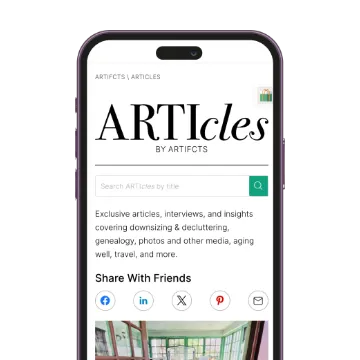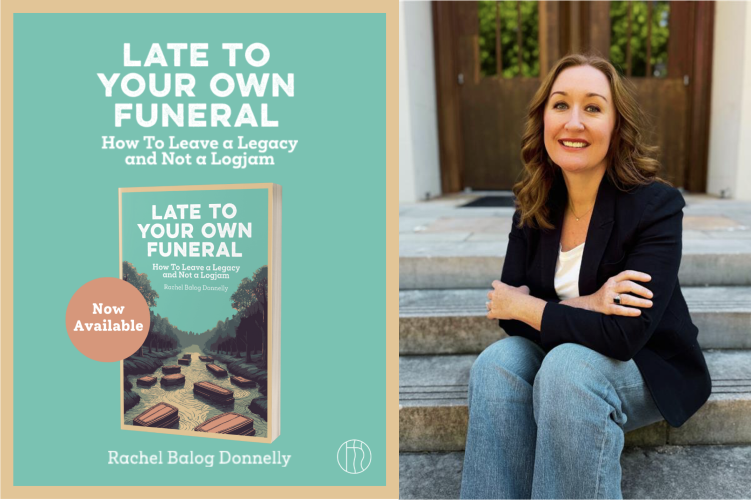August is Make a Will month and although it is probably not a holiday (or month!) that we tend to celebrate, it's a topic that we should all address at some point or another. If you happen to be one of the nearly 12 percent of Americans on holiday this August and you're reading today's ARTIcles story, nothing says I love you like sinking your toes into the sand next to your partner and striking up a conversation about end of life planning.
We invited Rachel Donnelly, founder of AfterLight, co-founder of Professionals of After Loss Services, and author of Late to Your Own Funeral: How To Leave A Legacy And Not A Logjam, to join us for a conversation about one of the few things that is gauranteed in life (in addition to taxes and aging). Read on for Rachel's practical advice, tips, and conversation starters. There truly is no time like the present to have the conversation we may all be putting off (and off).
Heather Nickerson, Co-Founder of Artifcts: Rachel, you are an after loss consultant. I think "after loss" is clear for all, but can you illuminate what services you provide in this role?
Rachel Donnelly: Sure! As an after loss consultant, I help people navigate the logistical and administrative tasks that are unavoidable after the death of a loved one. This role encompasses a wide range of responsibilities, including organizing and closing accounts, coordinating and completing forms, locating and securing necessary documents, and managing estate clean-outs or disposing of tangible personal property, as well as working with attorneys, financial advisors, and other professionals. I’m essentially the project manager you didn’t know you’d need when someone dies, helping clients navigate challenges like being overwhelmed, missteps, and missed deadlines.
Nickerson: So not all your services are necessarily offered literally after someone dies, sometimes it's about preparedness for that eventual reality we'll all face?
Donnelly: Yes, and after working with hundreds of clients, I know the common blind spots that people overlook as part of their estate planning and organization. I can serve as their “personal trainer” for estate organization, acting as an accountability partner and coach before something happens. That might mean organizing estate documents and digital assets, inventorying their belongings, or making sure their executor isn’t left guessing. Think of it as doing your loved ones a huge favor in advance. It’s the “leave a legacy and not a logjam” approach.
Nickerson: Who typically calls you in an after loss scenario? Is it the estate executor, aka next of kin, who really isn't sure what on earth to do now?
Donnelly: Yes. My client is usually the named executor, a surviving spouse, or an adult child who has just lost a parent. They're grieving and overwhelmed, confused about what to do first, and feel like they’re drowning in paperwork and tasks. That’s when I step in to bring order to the chaos.
Nickerson: What led you to take the leap from being the founder of your own after loss business at AfterLight to co-founding an organization to train others—Professionals of After Loss Services (PALS)?
Donnelly: What began as an informal networking group of women with businesses similar to mine has grown into the first and only dedicated community for after loss professionals. There is a significant need for professionals who are both trained and experienced in handling loss situations. While the field is growing quickly, there is still a gap in connection, consistency, and shared knowledge.
We created PALS to close that gap by building a network of trained, vetted professionals who understand the unique needs of clients after a loss. Our mission is to raise the standard of care while fostering a supportive community of pros who truly “get it.” We bring together people who are passionate about helping families navigate the administrative and logistical challenges of settling an estate while grieving. Whether you already serve families after a loss or are exploring how to begin, PALS is the place to learn, connect, and grow. As we like to say at PALS, a rising tide lifts all boats.
Nickerson: Among PALS-trained professionals, are there subspecialties? For example, do some professionals work more with widows or with families who have lost a child?
Donnelly: Yes, absolutely. While all PALS-trained professionals have a strong foundation in after loss logistics, many bring their own unique backgrounds to the table. Some focus more on grief support, others on estate organizing or clean-outs. We also have professionals who specialize in working with widows, the sandwich generation, or solo agers. It’s not one-size-fits-all, and that is what makes the network so valuable.
Nickerson: You also have “The checklist of death," not something most people probably hear on a daily basis. Where do you see the most mistakes made? What is most commonly overlooked? What are the first three steps someone should take in nearly any after loss scenario?
Donnelly: I love that phrase because it’s real. The biggest mistake I see is people jumping straight into tasks like cleaning out the house or closing accounts without understanding that there is often a specific order these steps should be followed according to the estate plan. Skipping that order or protocol can create significant problems later.
Most commonly overlooked? Digital assets. People often forget about email, cloud accounts, subscriptions, and social media, which can hold financial, exchange, or sentimental value.
As for first steps, aside from the funeral or memorial:
-
-
- Secure the home and cars, and forward the mail.
- Locate the will, trust, and other important documents.
- Make a detailed list of what they owe and what they own, which will be crucial during the estate settlement process.
-
Nickerson: And last but not least, you are a published author. What’s the feedback been like on your new book? Are you hearing from readers about "ah ha" moments?
Donnelly: It’s been humbling and amazing. People tell me Late To Your Own Funeral: How To Leave A Legacy And Not A Logjam is the first book they’ve read on this topic that doesn’t make them feel like they’re reading a legal manual—or a eulogy. I’ve had so many people tell me they’ve given this to their aging parents, who would never even broach the subject with them, and now they’re meeting with attorneys and formalizing their estate planning documents. One woman said, “This made me laugh, cry, and then finally get my affairs in order.” That’s exactly what I was going for: clarity, empathy, and a little irreverence to make it all feel more doable.
###
Interested in learning more about becoming a Professional of After Loss Services? Join Rachel and our co-founder Heather at the Professionals of After Loss Services Conference this October in Atlanta, GA. Click here for more details.
© 2025 Artifcts, Inc. All Rights Reserved.

























